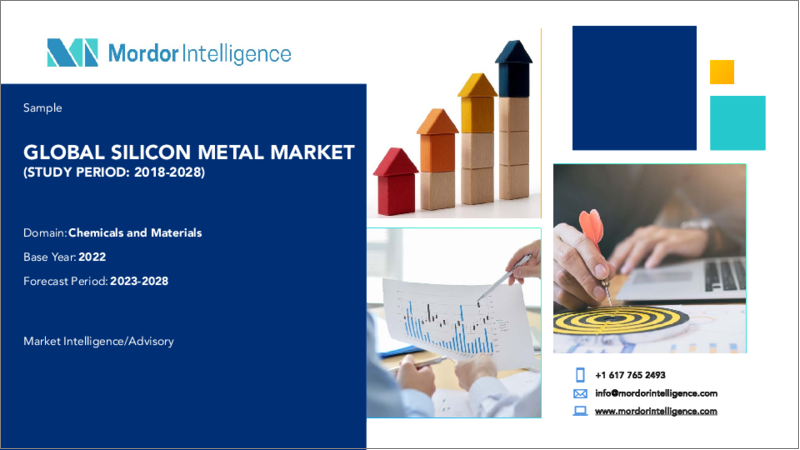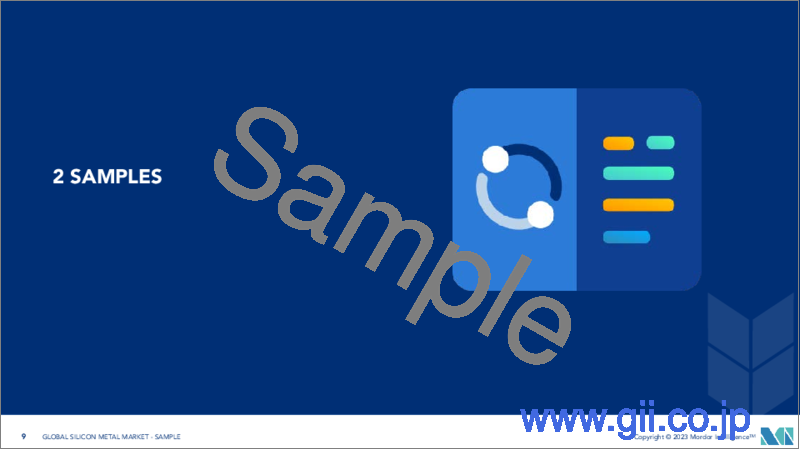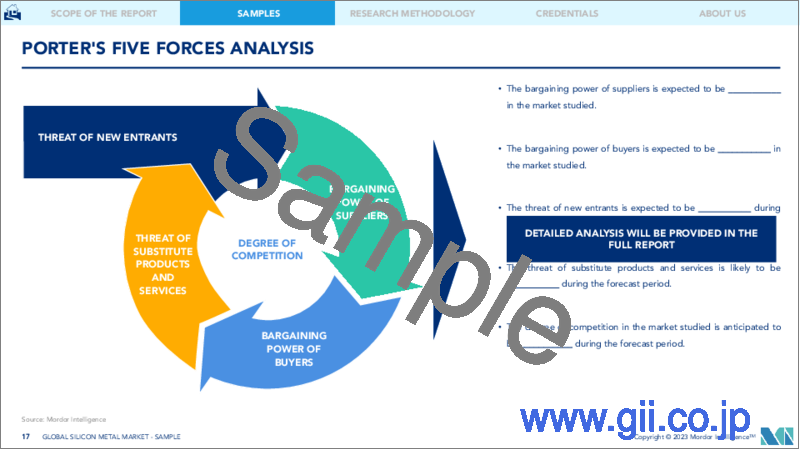|
|
市場調査レポート
商品コード
1198331
金属ケイ素市場- 成長、動向、予測(2023年-2028年)Silicon Metal Market - Growth, Trends, and Forecast (2023 - 2028) |
||||||
|
● お客様のご希望に応じて、既存データの加工や未掲載情報(例:国別セグメント)の追加などの対応が可能です。 詳細はお問い合わせください。 |
|||||||
| 金属ケイ素市場- 成長、動向、予測(2023年-2028年) |
|
出版日: 2023年01月23日
発行: Mordor Intelligence
ページ情報: 英文 160 Pages
納期: 2~3営業日
|
- 全表示
- 概要
- 目次
金属ケイ素の世界市場は、今年末までに2,900キロトン以上に達すると推定され、予測期間中に5%を超えるCAGRで推移すると予測されています。
COVID-19の大流行は金属ケイ素市場にとって大きな課題であり、世界中のメーカーのサプライチェーンに直接影響を与え、ウイルス拡散のリスクを最小限に抑えるために生産設備を停止させました。
主なハイライト
- 電気自動車の需要増と世界の自動車生産の増加により、アルミニウム-シリコン合金の需要増が金属ケイ素の消費を促進すると予想されます。また、スマート携帯電話、ラップトップ、タブレット、その他の電子ガジェットの使用量が増加していることも、金属ケイ素市場を牽引すると予想されます。
- ただし、中国におけるシリコン生産量の低下が市場の成長を阻害する可能性があります。
- 現在の技術を改善することで生産コストを削減する施策は、予測期間を通じて市場に潜在的な成長機会をもたらすと予測されます。
- アジア太平洋地域は最も高い市場シェアを占めており、予測期間中、市場を独占すると予想されます。
金属ケイ素の市場動向
ソーラーパネルからの需要急増
- シリコンは、太陽電池に最も多く使用されている半導体材料であり、現在販売されているモジュールの約95%を占めています。金属シリコンは、精製することで半導体や太陽電池の基となる高純度シリコンに変換することができます。したがって、太陽電池の製造に使用することができます。
- 太陽光発電産業は、世界で最も急成長している産業の一つです。国際エネルギー機関(IEA)によると、この分野は世界の純発電容量のほぼ3分の2を占めています。
- IEAの予測によると、再生可能エネルギーの発電容量は2019年から2023年の間に50%拡大し、主に太陽光発電がリードすると予想されています。予想される成長のほぼ60%を太陽光発電が占めると予想されます。2017年の世界の再生可能エネルギー純容量におけるPVのシェアは55.4%で、2022年には188.6GW(59.1%)に上昇します。2020年はCOVID-19のプロジェクトに対する影響により記録的な減速となったが、インド、ブラジル、南アフリカで太陽光発電の成長が続けば、197.3GWに達し、世界の再生可能エネルギー供給の約62.3%を占める可能性があると予測されています。
- インドでは、長期にわたって延期されていた大規模な電力事業プロジェクトが稼動し、2022年には2020年比で3倍の容量増加が見込まれます。
- 米国では、26%のITCがさらに1年延長され、プロジェクトの経済的魅力が増すため、2022年の設備容量の増加が続くと予想されます。コスト削減と税額控除の継続により、2022年には分散型PVが米国PV成長率の30%近くを占めると見られます。
- 2021年第3四半期の米国太陽光発電市場の設置量は5.4GWで、2020年第3四半期より33%増加しました。2021年第3四半期に設置された太陽光発電用ユーティリティスケールのうち、テキサス州とバージニア州が半分以上を占めました。
- 2021年第1四半期~第3四半期の米国の太陽光発電量は54%で、2020年には44%だっています。2022年の市場には、サプライチェーンの制約と原材料価格の上昇がネガティブな影響を与えると予想されます。
- 新・再生可能エネルギー省(MNRE)によると、2021年末時点でインドは全世界の太陽光発電の導入量において4位となっています。太陽光発電の設備容量は2022年11月30日時点で約61.97GWに達しています。インドの太陽光発電の関税は現在非常に競争力があり、グリッドパリティを達成しています。
- 上記のような新興国市場の開拓により、予測期間を通じて太陽光発電産業におけるシリコーン金属市場が牽引されると予想されます。
中国がアジア太平洋を支配する
- 中国は、さまざまな産業からのシリコン需要の増加により、アジア太平洋地域の金属ケイ素市場を独占しています。
- 金属ケイ素の最も重要な用途は、シリコーン(接着剤およびシーラント、潤滑剤、化学薬品、その他)とアルミニウム合金です。これらの製品の主な用途には、自動車、建築・建設、工業、その他のエンドユーザー産業が含まれます。
- 中国における主要な電気自動車メーカーには、テスラ、BYD社、ニオ社などがあります。中国政府は、2025年までに最低5,000台、2030年までに100万台の燃料電池電気自動車を導入することを計画しています。
- 政府による電気自動車、ハイブリッド車、燃料電池車の普及促進は、予測期間中の市場の牽引役となることが予想されます。同国では電気自動車の需要が拡大していることから、アルミニウム合金、シリコン接着剤、半導体のニーズが高まっています。
- 同国は世界有数のステンレス鋼の生産国です。同国は2021年に13億3667万トンの鋼材を生産し、2020年に比べて0.6%増加しました。中国の2021年のステンレス鋼粗鋼生産量は3063万トンと推定され、2020年に比べ49万3千トン、1.64%増加しました。
- 世界トップの太陽光発電製造企業であるJinkoSolar、JA Solar、Trina Solarは中国に本社を構えています。同国における太陽電池の製造量は、過去2年間で飛躍的に増加しています。太陽電池の工業生産量は、157,286千キロワット時から2021年には234,054千キロワット時となり、42.1%増加しました。
- 中国は、携帯電話やノートパソコンなどの電化製品を生産するための投資先として最適な場所です。世界の主要メーカーは、今後の需要急増に対応するため、中国市場に多額の資本を投下しています。
- これらの要因から、中国はアジア太平洋地域を支配すると予想されます。
金属ケイ素市場の競合他社分析
金属ケイ素市場は、部分的に統合されています。主要企業(順不同)には、Hoshine Silicon Industry、Ferroglobe、Elkem、Dow、Wacker Chemie AGが含まれます。
その他の特典
- エクセル形式の市場予測(ME)シート
- アナリストによる3ヶ月間のサポート
目次
第1章 イントロダクション
- 調査の前提条件
- 調査範囲
第2章 調査手法
第3章 エグゼクティブサマリー
第4章 市場力学
- 促進要因
- 自動車産業からの需要急増
- 太陽電池産業での使用拡大
- 様々なエンドユーザーからのシリコーン需要の増加
- 抑制要因
- 中国におけるシリコン生産量の低下
- その他の抑制要因
- 産業バリューチェーン分析
- ポーターのファイブフォース分析
- 供給企業の交渉力
- 買い手の交渉力
- 新規参入業者の脅威
- 代替品の脅威
- 競合の度合い
第5章 市場セグメンテーション(市場規模(数量ベース)
- 製品タイプ
- 冶金用グレード
- 化学グレード
- 用途別
- アルミニウム合金
- 半導体
- ソーラーパネル
- シリコーン
- その他の用途
- 地域別
- アジア太平洋地域
- 中国
- インド
- 日本
- 韓国
- その他アジア太平洋地域
- 北米
- 米国
- カナダ
- メキシコ
- 欧州
- ドイツ
- 英国
- イタリア
- フランス
- その他欧州
- 南米
- ブラジル
- アルゼンチン
- その他の南米地域
- 中東地域
- サウジアラビア
- 南アフリカ共和国
- その他の中東地域
- アジア太平洋地域
第6章 競合情勢
- M&A、合弁事業、協業、契約
- 市場シェア(%)分析
- 主要なプレーヤーが採用する戦略
- 企業プロファイル
- Anyang Huatuo Metallurgy
- Dow
- Elkem
- Ferroglobe
- Hoshine Silicon Industry Co. Ltd
- Liasa
- Minasligas
- Mississipi Silicon
- PCC SE
- RIMA Industrial
- Rusal
- Shin-Etsu Chemical Co. Ltd
- Wacker Chemie AG
- Zhejiang Kaihua Yuantong Silicon Industry Co. Ltd
第7章 市場機会と今後の動向
- 既存技術の革新による生産コスト削減の取り組み
The global silicon metal market is estimated to reach over 2,900 kilotons by the end of this year and is projected to register a CAGR of over 5% during the forecasted period.
The COVID-19 pandemic was a significant challenge for the silicon metal market, directly affecting the manufacturer's supply chain across the globe and shutting down production facilities to minimize the risk of virus spread.
Key Highlights
- Increased demand for aluminum-silicon alloys is expected to fuel the silicon metals consumption due to the increasing demand for electric vehicles and increased automobile production globally. Also, the growing usage of smart cellular phones, laptops, tablets, and other electronic gadgets is expected to drive the silicon metal market.
- However, lower silicon production in China may hinder the market's growth.
- Measures to reduce production costs by improving current technologies are projected to create potential growth opportunities for the market throughout the forecast period.
- The Asia-Pacific accounts for the highest market share and is expected to dominate the market during the forecast period.
Silicon Metal Market Trends
Surging Demand from the Solar Panels
- Silicon is the most common semiconductor material in solar cells, representing approximately 95% of the modules sold today. Metallurgical silicon, on purification, can be converted into high-purity silicon, which is the basis for semiconductors or solar cells. Hence, it can be used in the production of solar cells.
- The solar power industry is one of the fastest-growing industries in the world. According to the International Energy Agency (IEA), the sector accounts for almost two-thirds of the net power capacity worldwide.
- According to the IEA forecast, renewable power capacity is expected to expand by 50% between 2019 and 2023, majorly led by solar PV. Solar PV is expected to account for almost 60% of the expected growth. The PV share in global net renewable capacity in 2017 was 55.4% which in 2022 rose to 188.6 GW (59.1%). After a record slowdown in 2020 brought on by the impact of COVID-19 on projects, the forecast states that if solar power growth continues in India, Brazil, and South Africa, it may reach 197.3 GW, accounting for around 62.3% of the world's renewable energy supply.
- As long-delayed large-scale utility projects come online, PV capacity additions in India are expected to triple in 2022 compared to 2020.
- In the United States, capacity additions will continue to grow in 2022 as the 26% ITC is extended for another year, making projects more economically appealing. With continued cost reductions and tax credits, distributed PV will account for nearly 30% of US PV growth in 2022.
- In the third quarter of 2021, the US solar market installed 5.4 GW, which was a 33% rise in solar capacity than the third quarter of 2020. Texas and Virginia accounted for more than half of the utility-scale for solar installation in Q3 of 2021.
- In Q1-Q3 of 2021, solar energy generated 54% of electricity in the US, which was 44% in 2020. Supply chain constraints and rising raw material prices are expected to impact the market in 2022 negatively.
- According to the Ministry of New and Renewable Energy (MNRE), India stands 4th in solar PV deployment across the globe as of the end of 2021. Solar power installed capacity reached around 61.97 GW as of 30th November 2022. India's solar tariff is very competitive today and achieved grid parity.
- The developments above are expected to drive the market for silicone metal in the solar industry through the forecast period.
China to Dominate the Asia-Pacific
- China dominates the silicon metal market in Asia-Pacific due to the growing demand for silicon from different industries.
- Silicones (adhesives and sealants, lubricants, chemicals, and others) and aluminium alloys are the most significant applications of silicon metal. The leading applications of these products include automotive, building and construction, industrial, and other end-user industries.
- Leading electric car manufacturers in China include Tesla, BYD Co., and Nio Inc. The Chinese government plans to have a minimum of 5,000 fuel-cell electric vehicles by 2025 and 1 million by 2030.
- The government's promotion of electric, hybrid, and fuel-cell electric vehicles is expected to drive the market during the forecast period. The growing demand for electric cars in the country is driving the need for aluminum alloys, silicon adhesives, and semiconductors.
- The country is one of the world's largest producers of stainless steel. The land produced 1,336.67 million tons of steel in 2021, which increased by 0.6% compared to 2020. China's stainless steel crude steel output in 2021 was estimated to be 30.63 million tons, with an increase of 493,000 tons or 1.64% compared to 2020.
- The top global solar PV manufacturing companies, JinkoSolar, JA Solar, and Trina Solar, have headquarters in China. Solar cell manufacturing in the country is increasing exponentially in the past two years. The industrial production of solar cells increased from 157,286-thousand-kilowatt hours to 234,054 thousand kilowatts in 2021, which increased by 42.1%.
- China is a prime location for investments in producing mobiles, laptops, and other electrical appliances. Major global manufacturers invested significant capital in the Chinese market to cope with the upcoming demand surge.
- Due to these factors, China is expected to dominate the Asia-Pacific region.
Silicon Metal Market Competitor Analysis
The silicon metal market is partially consolidated. The major companies (not in any particular order) include Hoshine Silicon Industry Co. Ltd, Ferroglobe, Elkem, Dow, and Wacker Chemie AG.
Additional Benefits:
- The market estimate (ME) sheet in Excel format
- 3 months of analyst support
TABLE OF CONTENTS
1 INTRODUCTION
- 1.1 Study Assumptions
- 1.2 Scope of the Study
2 RESEARCH METHODOLOGY
3 EXECUTIVE SUMMARY
4 MARKET DYNAMICS
- 4.1 Drivers
- 4.1.1 Surging Demand from the Automotive Industry
- 4.1.2 Increasing Use in the Solar Industry
- 4.1.3 Increasing Demand for Silicones from Different End Users
- 4.2 Restraints
- 4.2.1 Lower Silicon Production in China
- 4.2.2 Other Restraints
- 4.3 Industry Value Chain Analysis
- 4.4 Porter's Five Forces Analysis
- 4.4.1 Bargaining Power of Suppliers
- 4.4.2 Bargaining Power of Buyers
- 4.4.3 Threat of New Entrants
- 4.4.4 Threat of Substitute Products and Services
- 4.4.5 Degree of Competition
5 MARKET SEGMENTATION (Market Size in Volume)
- 5.1 Product Type
- 5.1.1 Metallurgy Grade
- 5.1.2 Chemical Grade
- 5.2 Application
- 5.2.1 Aluminum Alloys
- 5.2.2 Semiconductors
- 5.2.3 Solar Panels
- 5.2.4 Silicones
- 5.2.5 Other Applications
- 5.3 Geography
- 5.3.1 Asia-Pacific
- 5.3.1.1 China
- 5.3.1.2 India
- 5.3.1.3 Japan
- 5.3.1.4 South Korea
- 5.3.1.5 Rest of Asia-Pacific
- 5.3.2 North America
- 5.3.2.1 United States
- 5.3.2.2 Canada
- 5.3.2.3 Mexico
- 5.3.3 Europe
- 5.3.3.1 Germany
- 5.3.3.2 United Kingdom
- 5.3.3.3 Italy
- 5.3.3.4 France
- 5.3.3.5 Rest of Europe
- 5.3.4 South America
- 5.3.4.1 Brazil
- 5.3.4.2 Argentina
- 5.3.4.3 Rest of South America
- 5.3.5 Middle-East
- 5.3.5.1 Saudi Arabia
- 5.3.5.2 South Africa
- 5.3.5.3 Rest of Middle-East
- 5.3.1 Asia-Pacific
6 COMPETITIVE LANDSCAPE
- 6.1 Mergers and Acquisitions, Joint Ventures, Collaborations, and Agreements
- 6.2 Market Share (%) Analysis
- 6.3 Strategies Adopted by Leading Players
- 6.4 Company Profiles
- 6.4.1 Anyang Huatuo Metallurgy
- 6.4.2 Dow
- 6.4.3 Elkem
- 6.4.4 Ferroglobe
- 6.4.5 Hoshine Silicon Industry Co. Ltd
- 6.4.6 Liasa
- 6.4.7 Minasligas
- 6.4.8 Mississipi Silicon
- 6.4.9 PCC SE
- 6.4.10 RIMA Industrial
- 6.4.11 Rusal
- 6.4.12 Shin-Etsu Chemical Co. Ltd
- 6.4.13 Wacker Chemie AG
- 6.4.14 Zhejiang Kaihua Yuantong Silicon Industry Co. Ltd
7 MARKET OPPORTUNITIES AND FUTURE TRENDS
- 7.1 Efforts to Reduce the Cost of Production by Innovating the Existing Technology




